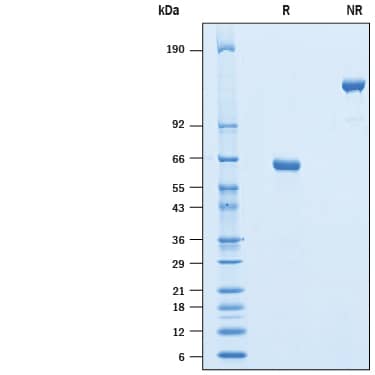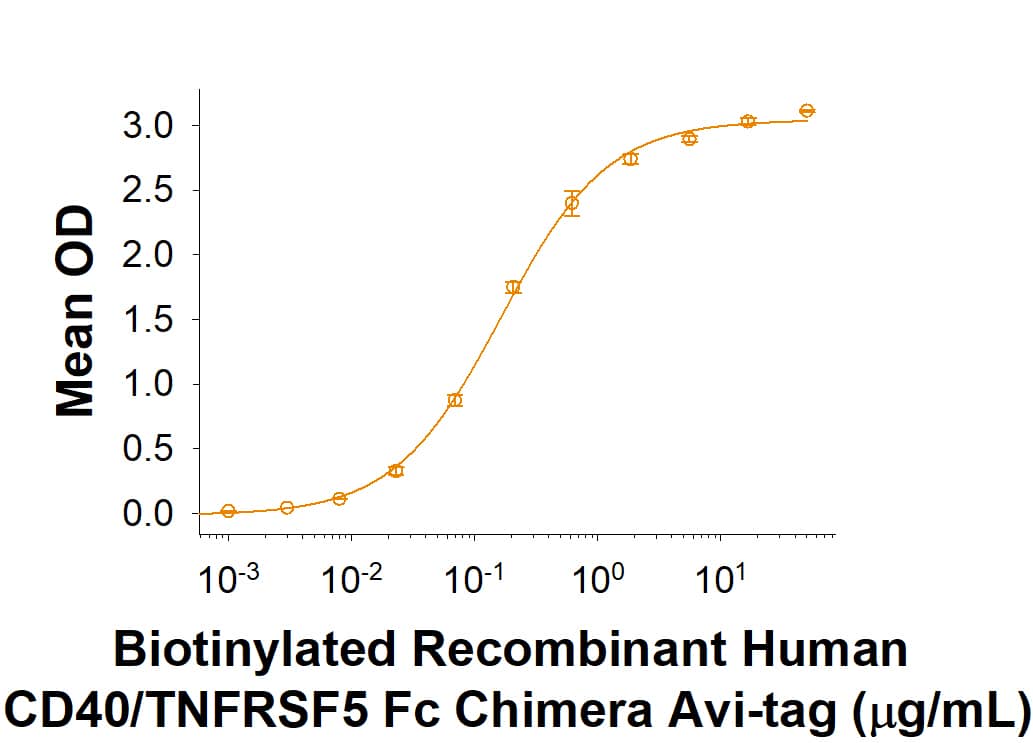Recombinant Human CD40/TNFRSF5 Fc Avi-tag Protein, CF
R&D Systems, part of Bio-Techne | Catalog # AVI10380

Key Product Details
Learn more about Avi-tag Biotinylated Proteins
Source
CHO
Accession #
Structure / Form
Disulfide-linked homodimer, biotinylated via Avi-tag
Conjugate
Biotin
Applications
Bioactivity
Product Specifications
Source
Chinese Hamster Ovary cell line, CHO-derived human CD40/TNFRSF5 protein
| Human CD40/TNFRSF5 (Glu21-Arg193) Accession # P25942.1 |
IEGRMD | Human IgG1 (Pro100-Lys330) |
Avi-tag |
Purity
>95%, by SDS-PAGE visualized with Silver Staining and quantitative densitometry by Coomassie® Blue Staining.
Endotoxin Level
<1.0 EU per 1 μg of the protein by the LAL method.
N-terminal Sequence Analysis
Glu21
Predicted Molecular Mass
48 kDa
SDS-PAGE
61-66 kDa, under reducing conditions
Activity
Measured by its binding ability in a functional ELISA.
When Recombinant Human CD40 Ligand/TNFSF5 Fc (HEK293-expressed, (Catalog # 6420-CL) mobilized at 2 μg/mL (100 μL/well), the concentration of Recombinant Human CD40/TNFRSF5 Fc Chimera Avi-tag (Catalog # AVI10380) that produces 50% optimal binding is 0.0400-0.320 μg/mL.
When Recombinant Human CD40 Ligand/TNFSF5 Fc (HEK293-expressed, (Catalog # 6420-CL) mobilized at 2 μg/mL (100 μL/well), the concentration of Recombinant Human CD40/TNFRSF5 Fc Chimera Avi-tag (Catalog # AVI10380) that produces 50% optimal binding is 0.0400-0.320 μg/mL.
Scientific Data Images for Recombinant Human CD40/TNFRSF5 Fc Avi-tag Protein, CF
Recombinant Human CD40/TNFRSF5 Fc Avi-tag Protein Binding Activity
When Recombinant Human CD40 Ligand/TNFSF5 (HEK293-expressed) Protein (Catalog # 6420-CL) is immobilized at 2 µg/mL, 100 µL/well, the concentration of Biotinylated Recombinant Human CD40/TNFRSF5 Fc Chimera Avi-tag (Catalog # AVI10380) that produces 50% optimal binding is 0.0400-0.320 μg/mL.Recombinant Human CD40/TNFRSF5 Fc Avi-tag Protein SDS-PAGE
2 μg/lane of Biotinylated Recombinant Human CD40/TNFRSF5 Fc Chimera Avi-tag (Catalog # AVI10380) was resolved with SDS-PAGE under reducing (R) and non-reducing (NR) conditions and visualized by Coomassie® Blue staining, showing bands at 61-66 kDa and 120-135 kDa, respectively.Formulation, Preparation and Storage
AVI10380
| Formulation | Lyophilized from a 0.2 μm filtered solution in PBS with Trehalose. |
| Reconstitution | Reconstitute at 500 μg/mL in PBS. |
| Shipping | The product is shipped at ambient temperature. Upon receipt, store it immediately at the temperature recommended below. |
| Stability & Storage | Use a manual defrost freezer and avoid repeated freeze-thaw cycles.
|
Background: CD40/TNFRSF5
References
- Banchereau, J. et al. (1994) Annu. Rev. Immunol. 12:881.
- Stamenkovic, I. et al. (1989) EMBO J. 8:1403.
- Eshel, D. et al. (2008) Mol. Immunol. 46:250.
- van Kooten, C. and J. Banchereau (1997) Curr. Opin. Immunol. 9:330.
- Schonbeck, U. et al. (1997) J. Biol. Chem. 272:19569.
- Eissner, G. et al. (2004) Cytokine Growth Factor Rev. 15:353.
- Rickert, R.C. et al. (2011) Immunol. Rev. 244:115.
- Elgueta, R. et al. (2009) Immunol. Rev. 229:152.
- Loskog, A.S. and A.G. Eliopoulos (2009) Semin. Immunol. 21:301.
- Hangalapura, B.N. et al. (2012) J. Gene Med. 14:416.
- Kornbluth, R.S. (2000) J. Leukoc. Biol. 68:373.
- Chougnet, C. (2003) J. Leukoc. Biol. 74:702.
- Pamukcu, B. et al. (2011) Ann. Med. 43:331.
- Hassan, G.S. et al. (2012) Immunobiology 217:521.
Alternate Names
CD40, TNFRSF5
Gene Symbol
CD40
UniProt
Additional CD40/TNFRSF5 Products
Product Documents for Recombinant Human CD40/TNFRSF5 Fc Avi-tag Protein, CF
Product Specific Notices for Recombinant Human CD40/TNFRSF5 Fc Avi-tag Protein, CF
For research use only
